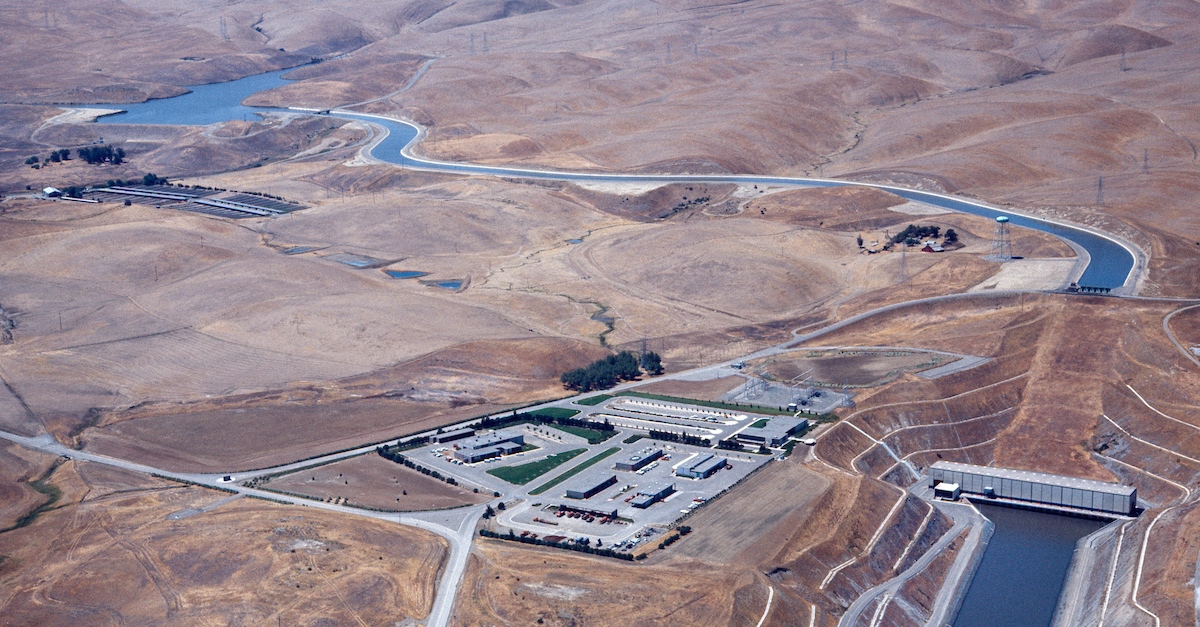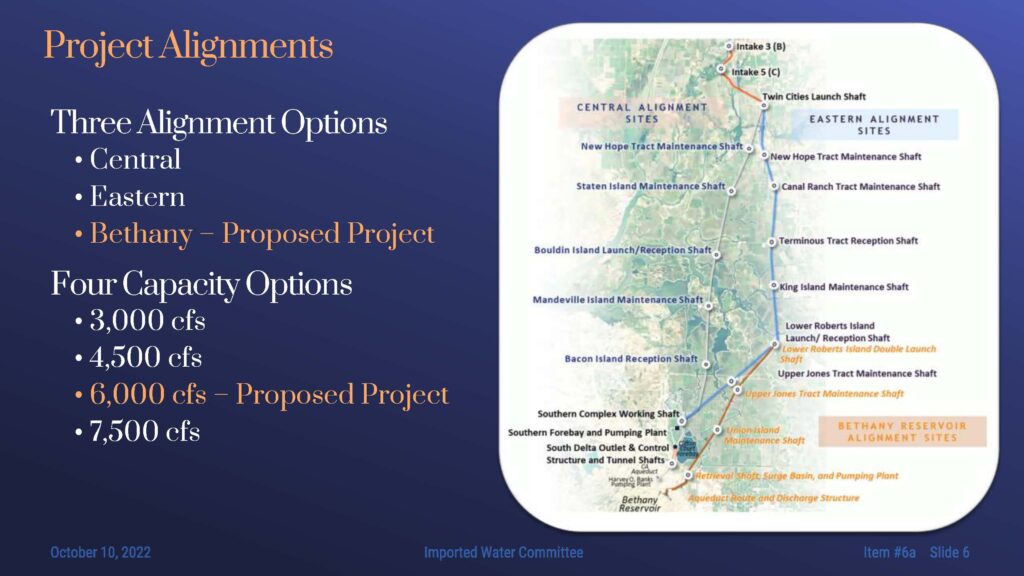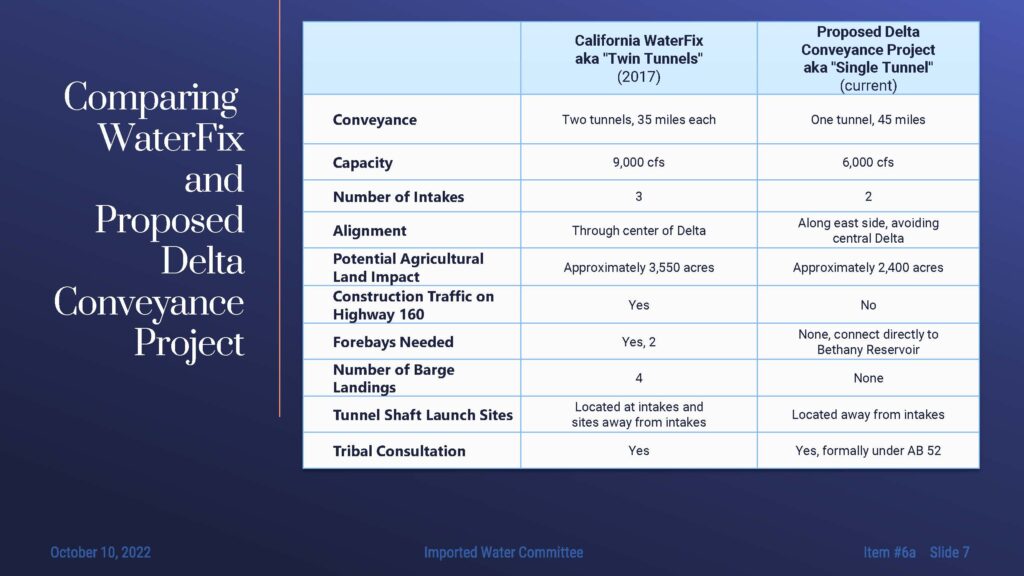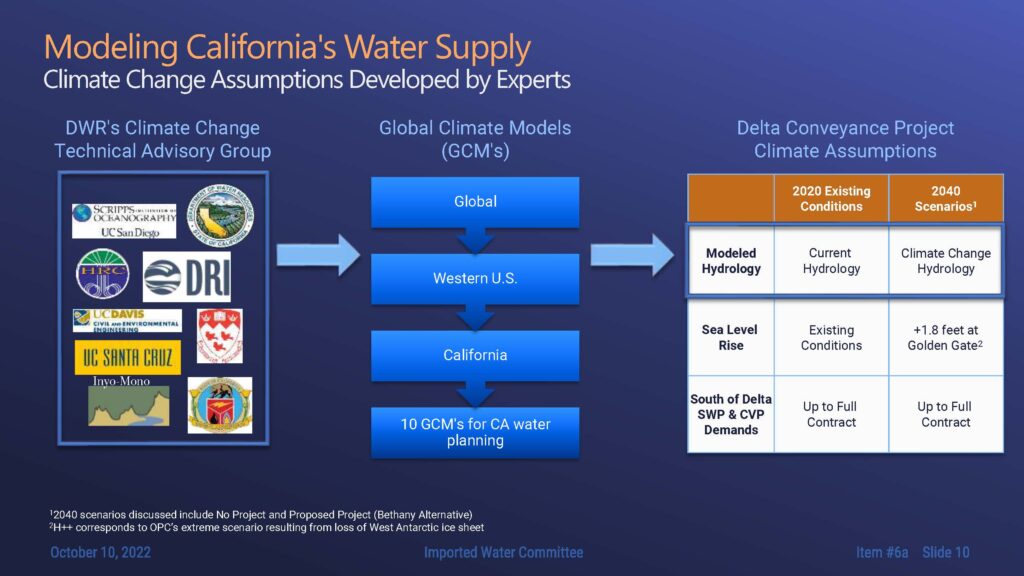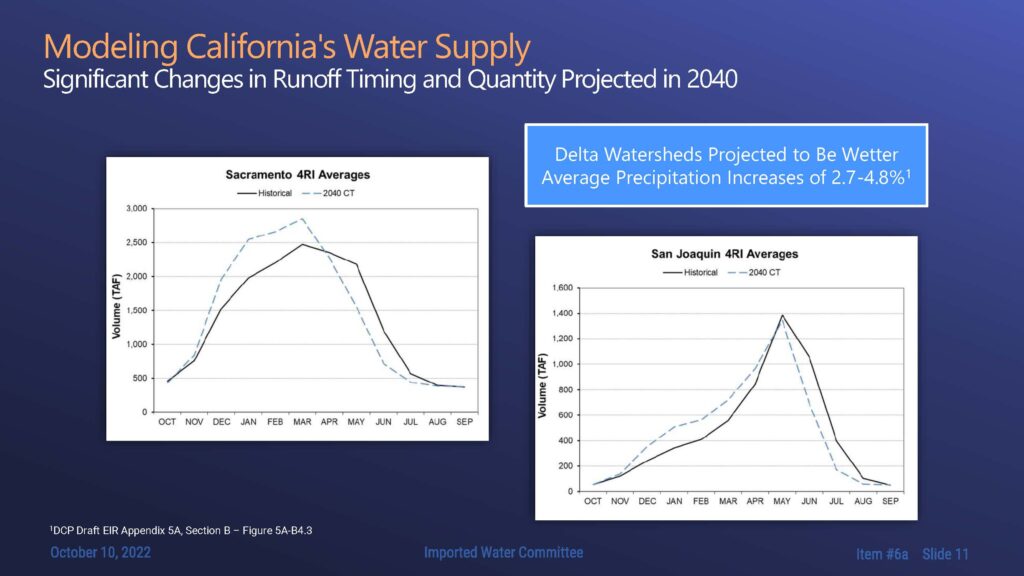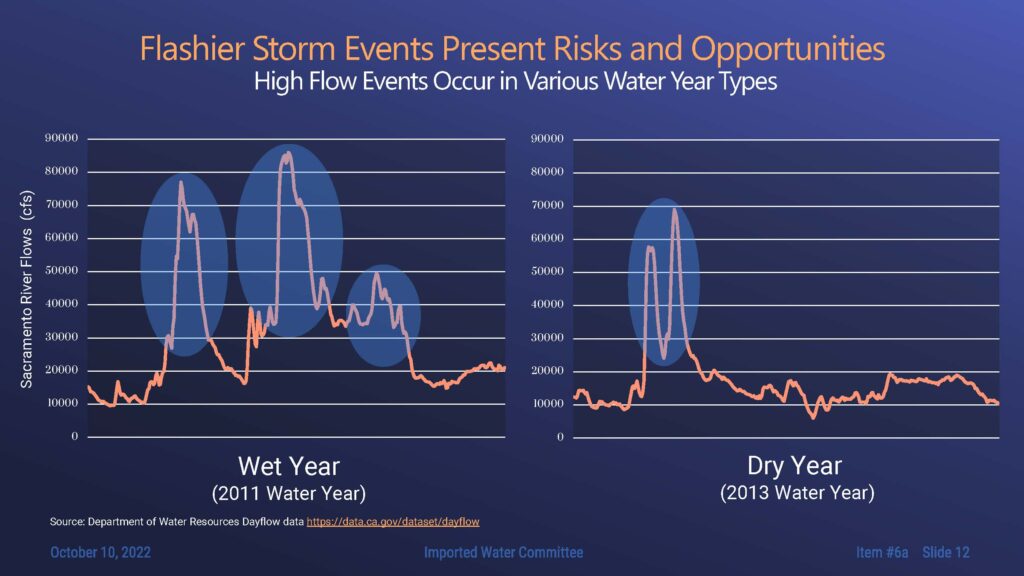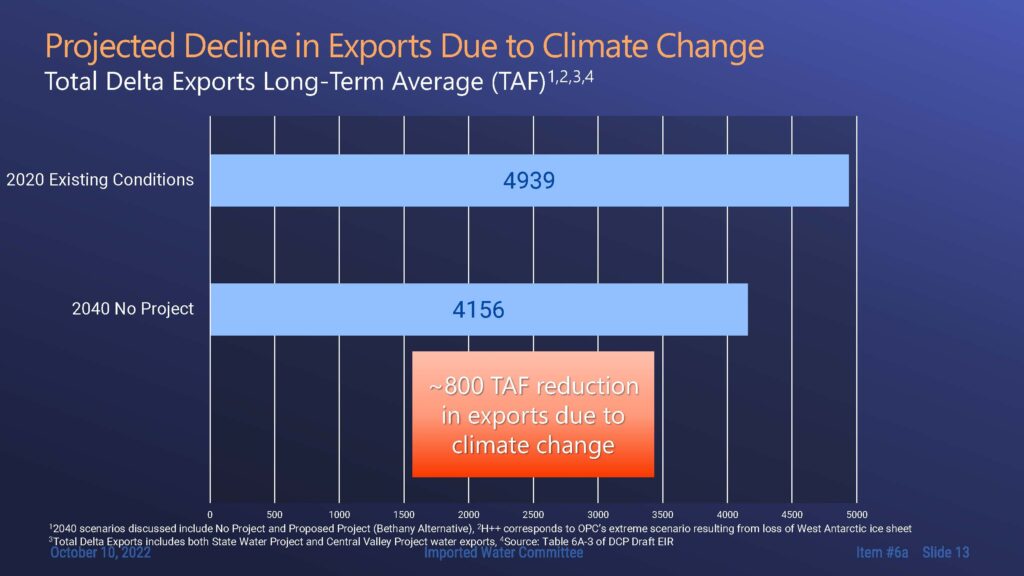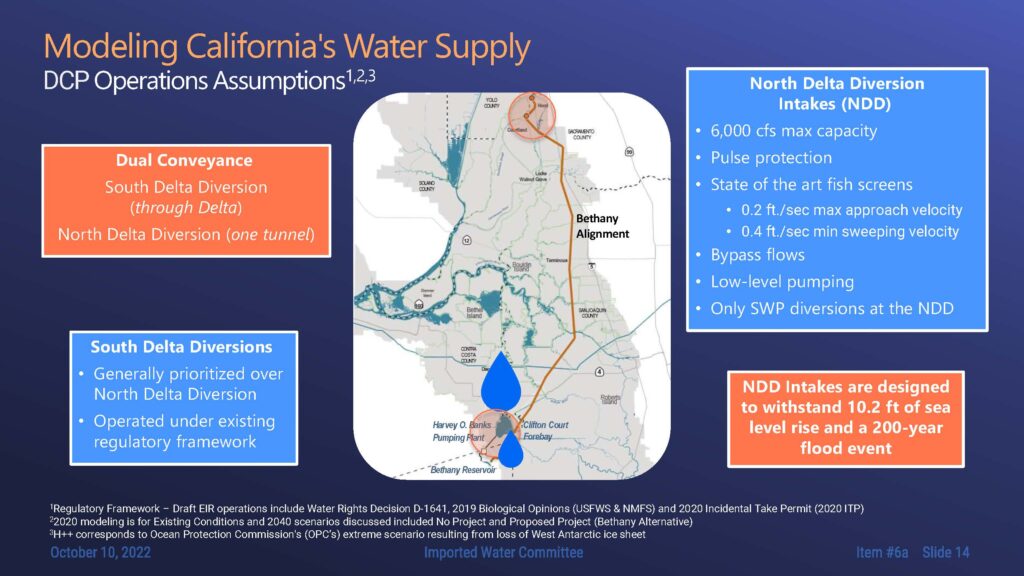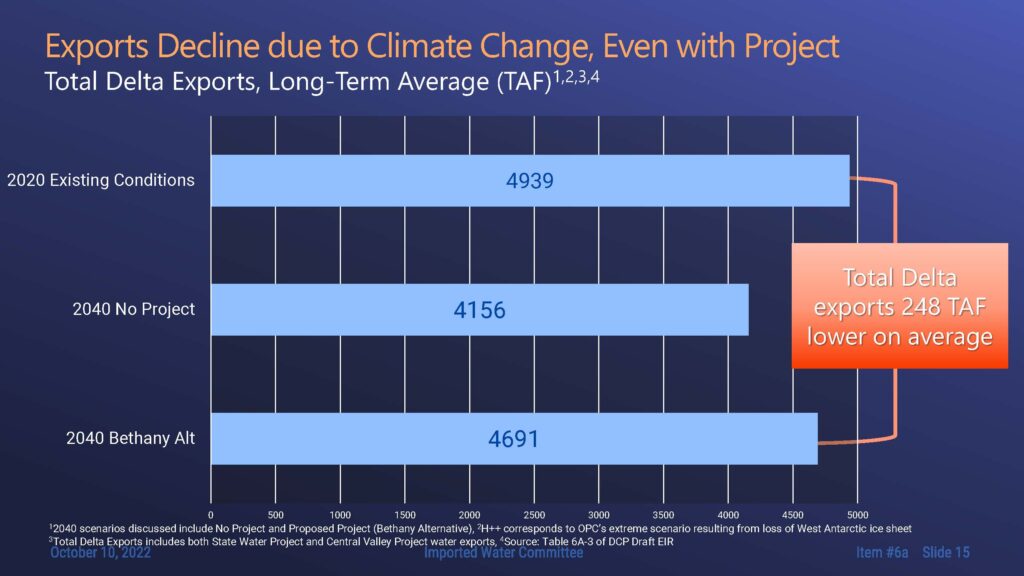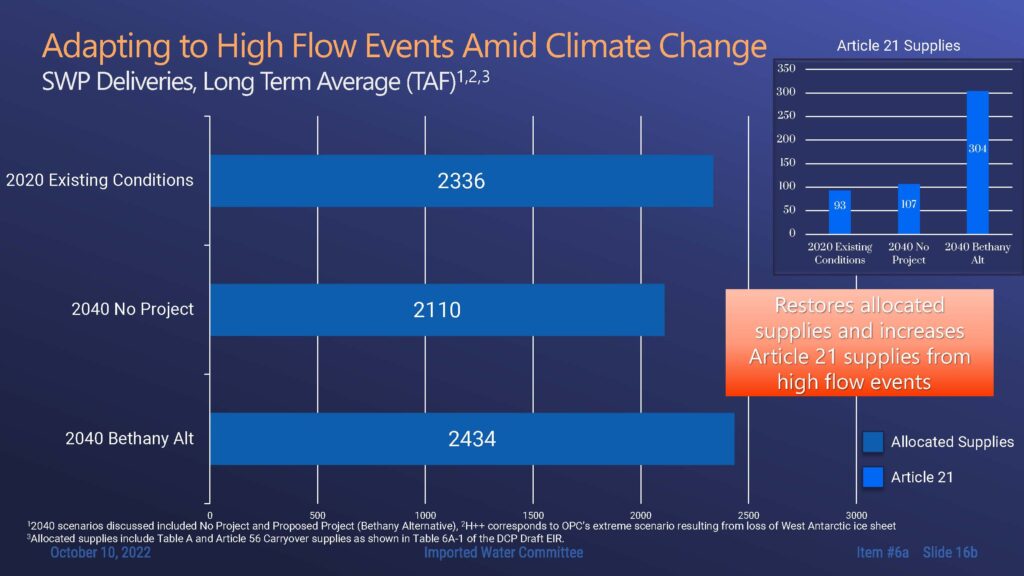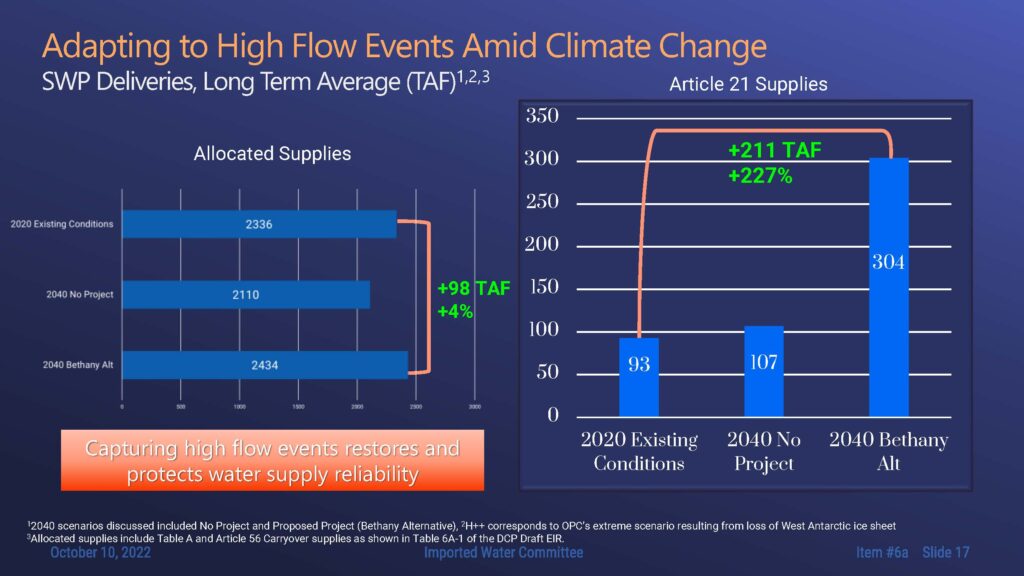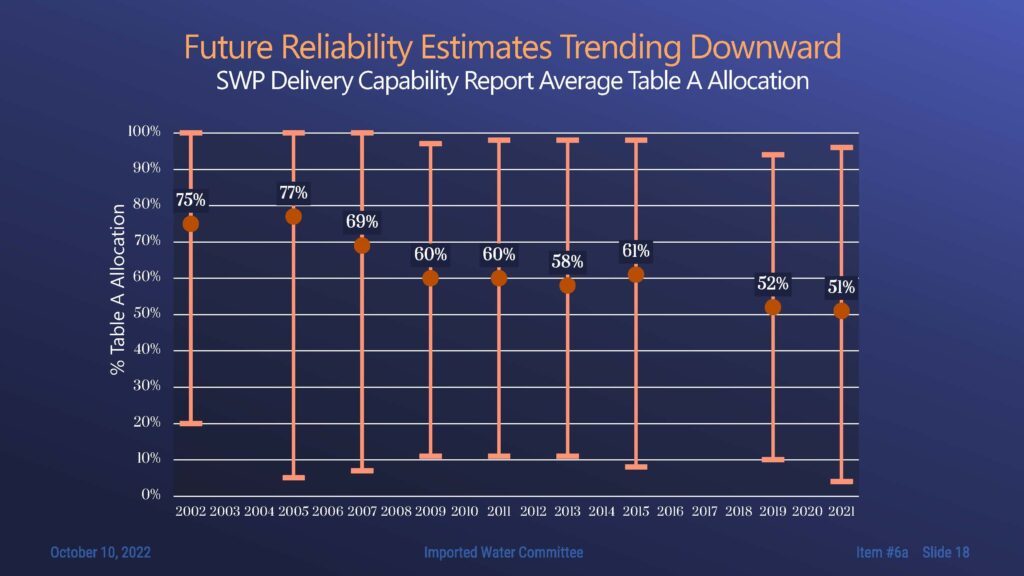The Department of Water Resources released the Environmental Impact Report on July 27, 2022; the extended public comment period will end on December 16, 2022. The document is over 20,000 pages, not including the appendices.
At the October meeting of Metropolitan’s Imported Water Committee, committee members were given the first of two briefings on the Delta Conveyance Project draft EIR. This briefing included a project overview, objectives and key elements; how climate change impacts the State Water Project and how the Delta conveyance performs under modeled scenarios; how the project relates to MWD’s One Water; and the role of the State Water Project in Metropolitan’s water resource portfolio.
Next month’s presentation will include a project overview recap, the Stakeholder Engagement Committee, environmental justice, community benefits program and framework, and tribal consultation.
Project Overview
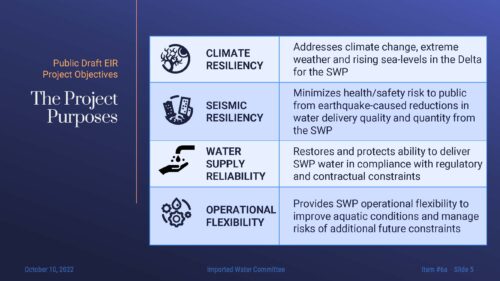 Program Manager Dee Bradshaw began by noting that California faces a future of water instability with more rain, less snow, and more frequent extreme events such as drought and flood. The Delta Conveyance Project provides climate adaptation updates to the State Water Project infrastructure in the Delta. The new infrastructure allows DWR to address sea level rise and climate change, minimizes water supply disruption due to seismic risk, and improves aquatic conditions in the Delta through more flexible State Water Project operations.
Program Manager Dee Bradshaw began by noting that California faces a future of water instability with more rain, less snow, and more frequent extreme events such as drought and flood. The Delta Conveyance Project provides climate adaptation updates to the State Water Project infrastructure in the Delta. The new infrastructure allows DWR to address sea level rise and climate change, minimizes water supply disruption due to seismic risk, and improves aquatic conditions in the Delta through more flexible State Water Project operations.
Each of the nine alternatives includes an intake or intakes to divert water in the North Delta, a tunnel to connect the existing facilities in the south Delta, shafts to use during tunnel construction and later as maintenance access, and facilities in the south Delta to pump water up to the surface and into existing conveyance facilities.
There are three tunnel alignment options: A central, eastern, and Bethany alignment. The new North Delta intake and conveyance facility alternatives range from 3000 CFS to 7500 CFS.
The Bethany alternative is the proposed project; this alternative extends the Eastern corridor to the existing Bethany reservoir and avoids the construction of a new forebay in the south Delta. The proposed project intakes would divert 6000 CFS of water from the intake facilities through state-of-the-art fish screens and convey it directly via a single tunnel on the eastern alignment to a new pumping plant and aqueduct complex in the south Delta. The alignment continues heading south to the existing Bethany reservoir on the California Aqueduct.
Ms. Bradshaw noted that identifying the Bethany reservoir alternative as the proposed project for the draft EIR does not indicate that DWR has decided to move forward with the Delta Conveyance Project, nor that the Bethany reservoir alignment will be the project that DWR approves. DWR will not decide on the project until after addressing public comments on the draft EIR as part of preparing and certifying the final EIR and making all necessary CEQA findings.
The table on the slide below compares the Delta Conveyance Project to its predecessor, the California WaterFix. The project has been refined to maximize water supply benefits for the State Water Project while minimizing impacts on Delta communities, a process informed by a Stakeholder Engagement Committee made up of community members who live and/or work in the Delta.
The California WaterFix proposed two tunnels with a capacity of 9000 CFS, whereas the Delta Conveyance Project was one tunnel with a capacity of 6000 CFS. The proposed alignment is routed primarily along the I-5 corridor, and by avoiding the central Delta and other design differences, the Delta Conveyance Project will lessen the impacts on agricultural land and redirect traffic impacts to interstates, highways, and railroads. The connection directly to the Bethany reservoir avoids the creation of new forebays and significantly reduces construction impacts and the project’s footprint. Not constructing tunnel shafts at the intakes will reduce construction traffic on local two-lane roadways. Longer drives by tunnel boring machines will require less tunnel shaft construction. And lastly, the Delta Conveyance Project is currently engaged in formal AB52 tribal cultural resources consultation.
Water Supply Reliability and Resiliency
Next, Jennifer Nevills, Program Manager, discussed the Delta Conveyance Project and its role in water supply reliability and resiliency. Metropolitan staff has been reviewing the document and have distilled it down to some of the key climate and operational assumptions, how those assumptions translate into water supplies and the climate change future, with and without the Delta Conveyance Project, and what kinds of uncertainties beyond what was analyzed for the purposes of CEQA, Metropolitan might want to consider in its long-term planning process.
Climate change assumptions
All climate assumptions used in the draft EIR were developed based on expert guidance. DWR assembled a technical advisory group consisting of state, academic, and other experts to evaluate global climate models for their applicability to California. The result of this process is a ce
ntral tendency assumption based on ten global climate models that are warmer and slightly wetter than current conditions. The central tendency scenario was used to inform the climate change hydrology underlying all the 2040 scenarios analyzed in the draft EIR.
The sea level rise assumptions come from the California Ocean Protection Council’s extreme climate scenario resulting from the loss of the West Antarctic Ice Sheet. This scenario includes almost two feet of sea level rise at the Golden Gate by 2040, just as the Delta Conveyance Project would be coming online. This represents a conservative approach to evaluating the impacts of sea level rise.
Demands are another aspect of future water supply modeling impacted by climate. Modeling in the draft EIR assumes up to full contract amounts for South of Delta, State Water Project, and Central Valley Project contractors. Ultimately, those demands, as well as demands upstream, are impacted by climate change in terms of evapotranspiration, land use changes, and other factors.
With the central tendency modeling indicating warmer and slightly wetter conditions in the future for California, the draft EIR projects significant changes in the hydrology, which are illustrated by the runoff projections shown in the draft EIR.
The two charts on the slide above show the monthly average runoff for the Sacramento and San Joaquin watersheds. The black line on each chart is the historical average monthly pattern, and the blue dashed line shows what is projected for 2040. The charts show a definitive shift in the timing of runoff in both watersheds, with more runoff occurring in the winter months and less in spring and summer. This is particularly evident in the Sacramento watershed, which is at a lower elevation on average than the San Joaquin. In addition, the bulk of that runoff is compressed into a shorter runoff season.
“What the draft EIR is showing is slightly more precipitation in total, more winter precipitation falling as rain or rain on snow events that result in runoff, and all of that runoff occurring in a shorter period of time,” said Ms. Nevills. “This Trifecta leads to an overall flashier hydrology and a higher frequency of high flow events.”
She pointed out that we’ve already been experiencing this in recent years and all year types. The slide below shows the hydrograph from 2011 and 2013. 2011 was a very wet year with consistently high flows in the Sacramento River, as well as some large peaks; in wet years, there can be limited opportunities to divert excess flows because overall project capacity and demands would likely be constraints. But 2013 was a dry year and flows in the Sacramento River peaked at 60 to 70,000 CFS early in the water year for a short period of time.
“These are the types of events that DWR is projecting to become more frequent in the future with climate change,” she said. “The Delta Conveyance Project would provide the capability to divert a small portion of these high flows, assuming all other conditions permit that diversion. However, without that capability, those peaks would be lost, and less water would be available overall due to those shifts in runoff that we discussed on the previous slide.”
The chart below shows the long-term average total Delta exports, which includes both State Water Project and Central Valley Project exports. The top bar is modeled average Delta exports under existing conditions; the second bar is average exports in 2040 with no project.
“The reduction in total exports between the top bar and the second bar is driven by climate change, sea level rise, and changing demands,” said Ms. Nevills. “There is an average annual reduction of just under 800,000 Delta Conveyance Project in total net Delta exports between existing conditions and 2040 no project that’s all attributable to climate impacts.”
Key operational assumptions for the proposed project
Dual conveyance operation: The State Water Project will continue to use the south Delta facilities to export water that flows through the Delta, consistent with current State Water Project operations. Water will also be moved through the proposed North Delta facilities. Using these two modes of conveyance is what is meant by the term ‘dual conveyance.’ The draft EIR assumes that South Delta diversions are generally prioritized over North Delta diversions, so the current operation of moving water through the Delta is maintained. The north Delta intakes would supplement operations when conditions are suitable.
Regulatory framework: The proposed project is assumed to operate under the existing regulatory framework, including D-1641 water quality standards, the 2019 biological opinions, and the 2020 incidental take permit. Ms. Nevills noted that it’s important to remember this when looking at the water supply results, as the 2040 scenarios do not incorporate any regulatory changes.
North Delta Diversions: The North Delta diversions would consist of two 3000 CFS intakes under the proposed project, and those facilities would only be used for State Water Project diversions. Several protections for fish are assumed to be in place for the intakes, including pulse protections, bypass flow criteria, low-level pumping, and state-of-the-art fish screens with velocity criteria that protect Delta smelt or other weak swimming fish exposed to the intake screens. The low approach velocity is intended to minimize effects associated with screen contact, while the sweeping velocity facilitates the passage of fish and debris past the intakes.
Sea level rise: The North Delta intakes are designed to withstand 10.2 feet of sea level rise at Golden Gate and a concurrent 200-year flood event; 10.2 feet is the Ocean Protection Council’s extreme sea level rise scenario for the year 2100. “Something to think about here is that the Delta Conveyance Project would just be coming online around 2040,” said Ms. Nevills. “Given the uncertainties of future climate change and the decades ahead, it is essential that the project is of sufficient size and capacity to ensure reliability amid changing conditions.”
So how much water?
The chart below shows the total Delta exports for both the State Water Project and the Central Valley Project under existing conditions and at 2040 with and without the project.
“The drop from existing conditions to the 2040 no-project scenario due to climate change was a little less than 800,000 Delta Conveyance Project, and we can see that with Delta Conveyance Project, that decrease is reduced to 240,000 Delta Conveyance Project on average,” said Ms. Nevills.
She noted some important points to take away from this slide. “First is that in both 2040 scenarios, overall Delta exports are lower on average than under existing conditions, so even with the project in place, total Delta exports do not reach the level of exports seen in the existing conditions scenario. The second is that the benefits resulting from Delta Conveyance Project are accrued solely to the State Water Project. Because the CVP is not a participant in the project, they’re essentially hit hard by climate change in both 2040 scenarios, and the project provides no appreciable benefits to them.”
This chart shows State Water Project deliveries. The top bar is modeled average SWP deliveries under existing conditions; the middle bar is the average deliveries in 2040 without the project, and the bottom bar is 2040 with the proposed project, so increases in State Water Project deliveries between the two 2040 scenarios are due to the project.
What’s driving the increase in water supply benefits?
Metropolitan staff used the modeling results in the draft EIR to determine what drives those water supply benefits.
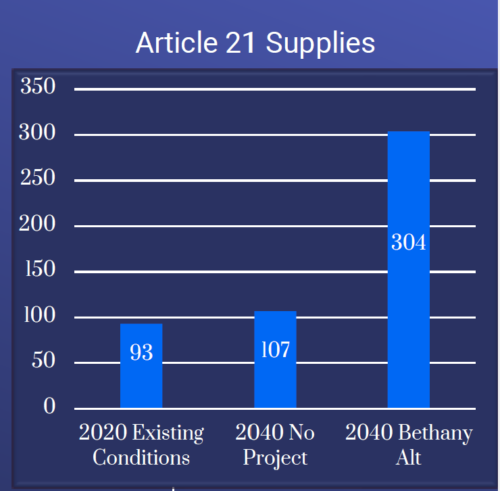 State Water Project supplies can be divided into allocated supplies and article 21 supplies. Allocated supplies are the Table A allocation and supplies from previous years held in carry-over storage. Article 21 supplies are available intermittently and only when project storage is full, and supplies are in excess of Table A demands. The chart in the upper left corner of the slide above shows the significant increase in Article 21 supplies with the project in 2040.
State Water Project supplies can be divided into allocated supplies and article 21 supplies. Allocated supplies are the Table A allocation and supplies from previous years held in carry-over storage. Article 21 supplies are available intermittently and only when project storage is full, and supplies are in excess of Table A demands. The chart in the upper left corner of the slide above shows the significant increase in Article 21 supplies with the project in 2040.
“Essentially, having the project in place restores allocated supplies to a little better than existing conditions and increases Article 21 supplies significantly,” said Ms. Nevills.
The chart on the left on the slide below shows allocated State Water Project supplies, and the graph on the right shows Article 21 supplies. “We see that Table A deliveries increased by about 100,000 Delta Conveyance Project on average compared to existing conditions and that Article 21 supplies increased by more than 200,000 acre-feet on average,” said Ms. Nevills.
“Many of the water supply benefits come from the proposed project’s ability to divert water during high flow events. This increase in Article 21 supplies is particularly important to contractors like Metropolitan. Metropolitan has a diverse storage portfolio with a lot of capacity, and when those excess supplies are available, we’re able to move water into storage and sure that those supplies will be there to help with demands and inevitable drought periods ahead.”
Uncertainty
The chart on the slide below shows the average future State Water Project deliveries as a percent of table A allocation from DWR’s Delivery Capability Report. DWR updates the report every two years as a normal course of business unrelated to the Delta Conveyance Project. Metropolitan regularly uses the Delivery Capability Report to support its long-term modeling and planning efforts.
“I’m showing you this slide because I want to introduce the notion of uncertainty,” said Ms. Nevills. “The Delivery Capability Report shows a consistent downward trend for expected future State Water Project deliveries over time. These reductions are primarily due to the changing regulatory environment, where increasingly stringent regulations have reduced the expected capability of the State Water Project. So when we talk about the water supply results shown in the draft EIR, we need to remember that they are based on one specific set of assumptions regarding operations, climate, and regulatory framework.”
“The draft EIR modeling does not include any changes in the regulatory framework between the existing conditions and 2040 scenarios. However, based on history, we can assume some uncertainty in that assumption.”
The draft EIR also provides a qualitative discussion of 2070 conditions which considers the uncertainty in future water demands for both agriculture and urban entities; uncertainty in climate modeling in terms of temperature, snowpack, runoff, and sea level rise; uncertainty in future regulatory actions; and uncertainty related to future project operations.
Ms. Nevills noted that the qualitative discussion of 2070 conditions provided in the draft EIR already goes above and beyond the requirements of CEQA, so if Metropolitan wanted to evaluate any future uncertainty surrounding the project, they would do so as part of their long-term planning process.
One Water
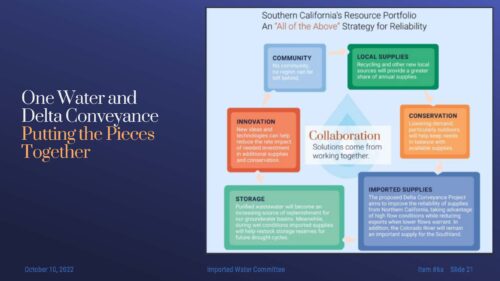 Nina Hawk, Policy Manager for Bay-Delta Initiatives, then discussed how the Delta Conveyance Project fits with Metropolitan’s One Water approach.
Nina Hawk, Policy Manager for Bay-Delta Initiatives, then discussed how the Delta Conveyance Project fits with Metropolitan’s One Water approach.
The key elements of the One Water approach are shown on the slide. The proposed Delta Conveyance Project aims to improve the reliability of supplies from Northern California and take advantage of high-flow events that are expected to increase in the future. Those imported water supplies help restock Metropolitan’s storage for future droughts.
“The proposed Delta Conveyance Project is not the only potential solution to shore up water supply reliability long-term for Metropolitan, but rather it’s an all of the above strategy that integrates innovation, helping to reduce rate impacts and drive ways to optimize systems,” said Ms. Hawk. “It includes communities and regions in the conversation. Local supplies such as recycled water help provide a greater share of annual supplies locally or within our region, and demand side management such as conservation – these are all elements which will be either needed or potentially analyzed by Metropolitan to help balance the precious water resources available for us to use into the future.”
The importance of the State Water Project to Metropolitan
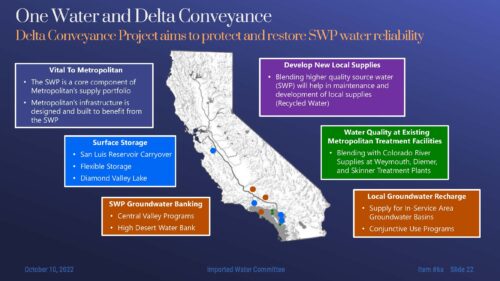 The State Water Project is a core component of Metropolitan’s water supply, and the infrastructure was designed and built to benefit from the State Water Project.
The State Water Project is a core component of Metropolitan’s water supply, and the infrastructure was designed and built to benefit from the State Water Project.
The supplies conveyed through the California Aqueduct provide about 25 to 30% of the total supplies used in the Metropolitan service area today. And in wet years, over 80% of total imported supplies come from the State Water Project.
Metropolitan’s infrastructure is designed within their service area to use State Water Project supplies, including the Jensen treatment plant, the largest drinking water plant in the US west of the Mississippi, that relies on the State Water Project, among other sources. The inland feeder travels 44 miles to deliver State Water Project to Diamond Valley Lake.
Surface storage is also key. Metropolitan uses San Luis Reservoir to store carry-over supplies in wet years upwards of 300,000 acre-feet. They rely on flexible storage accounts in Perris and Castaic Reservoirs during dry years utilizing the State Water Project. And Diamond Valley lake can store over 800,000 acre-feet of State Water Project supplies via the inland feeder.
Metropolitan also has State Water Project groundwater banking partnerships or assets in the Central Valley, such as Kern Delta, Semitropic, and Arvin Edison, as well as the planned AVEK High Desert Water Bank.
State Water Project supplies are used to recharge groundwater within the service area. Replenishing those local aquifers allows conjunctive use programs to exist or at least help shore them up.
The low salinity supplies from the State Water Project provide many water quality benefits. SWP supplies help meet the region’s groundwater standards, salinity management plans, and targets. State Water Project water is blended with Colorado River supplies to reduce salinity and total dissolved solids. Blending with higher quality State Water Project water helps with the development of local supplies such as recycled water.
Key takeaways
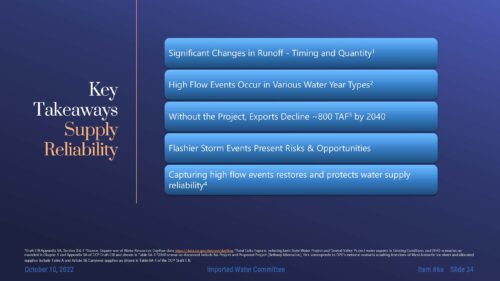 The draft EIR anticipates that with climate change, significant changes in runoff will occur in both timing and quantity. Flashier storm events and high flow events will occur in all water year types, wet and dry years.
The draft EIR anticipates that with climate change, significant changes in runoff will occur in both timing and quantity. Flashier storm events and high flow events will occur in all water year types, wet and dry years.
“If the Delta Conveyance Project had been built and in operation, DWR estimates that approximately 236,000 acre-feet of water would have been captured last year during those high flow storm events even though it was a dry year,” noted Ms. Hawk.
Without the proposed project in operation, it is anticipated the total exports for both the CVP and State Water Project will decline by approximately 800,000 acre-feet by 2040.
The flashier storm events will present risks and opportunities, as capturing high-flow events restores and protects water supply reliability.
Next steps
- Metropolitan staff will continue to report to the committee on the activities of the Delta Conveyance Design and Construction Authority and the Delta Conveyance Finance Authority.
- Updates on the planning and permitting activities will be provided on an ongoing basis by staff.
- The project cost estimate and cost-benefit analysis are anticipated to be available sometime between the fall of 2023 and the spring of 2024 and will be presented when available.
- Continued project funding for board discussion and deliberation at Metropolitan is anticipated by mid-2024 at the latest.
- Click here for the Delta Conveyance Project page at Maven’s Notebook.
- Click here for more coverage of the Delta Conveyance Project on Maven’s Notebook.
- I’ll just note that this project is controversial. Here’s what some of the project opponents have to say.


